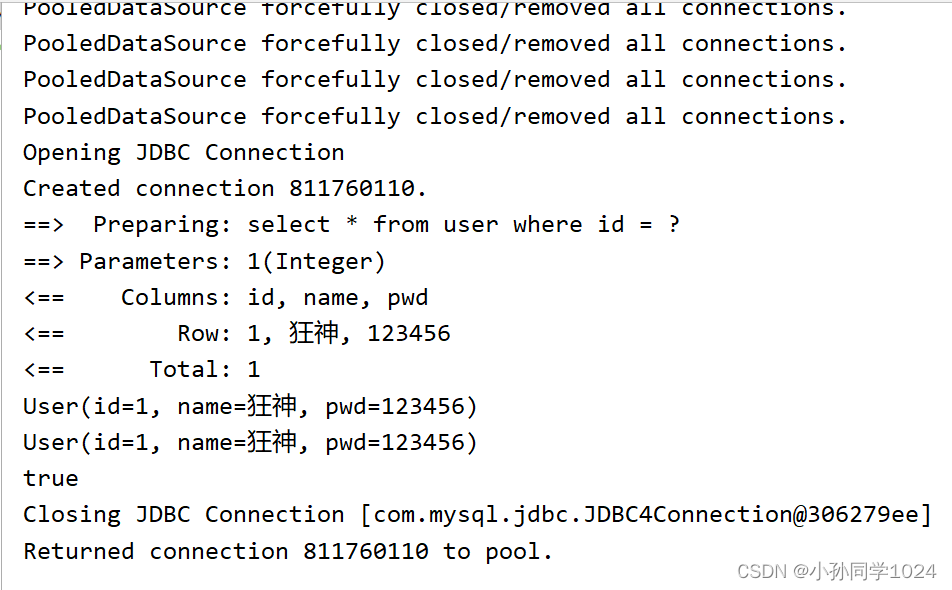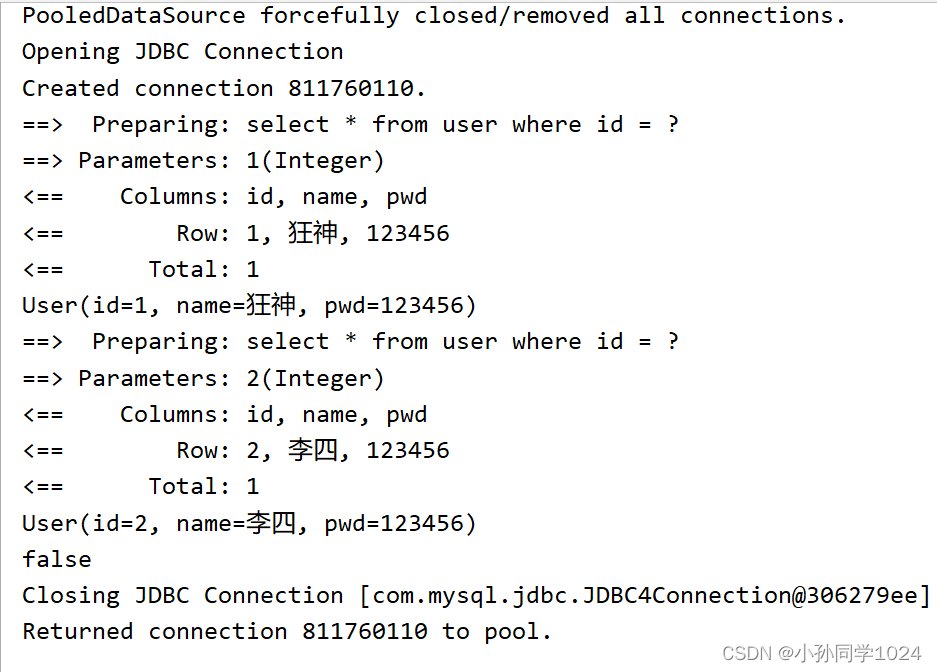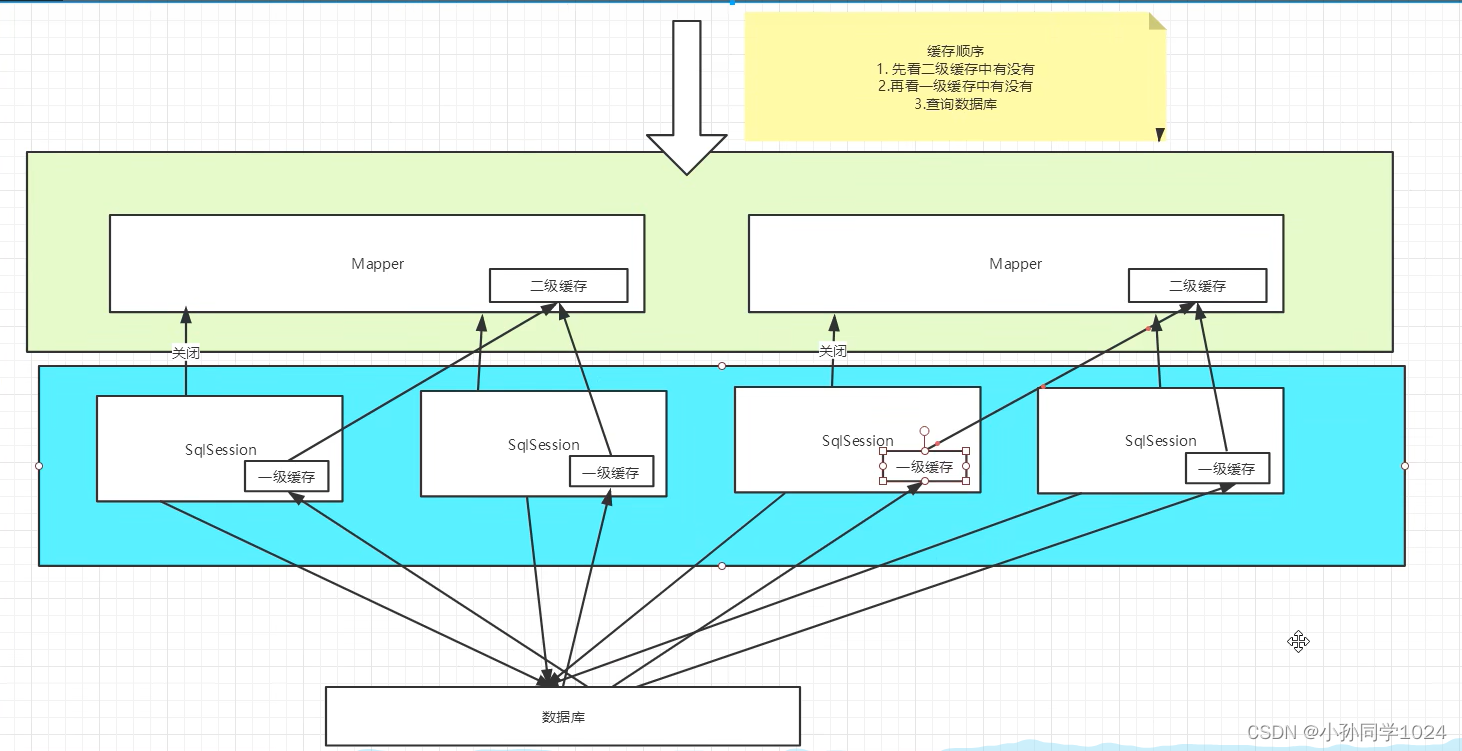Java全栈课程之Mybatis详解——缓存
一、简介
????????1.什么是缓存[Cache]?
??????????????? ① 存在内存中的临时数据。
??????????????? ② 将用户经常查询的数据放在缓存(内存)中,用户去查询数据就不用从磁盘上(关系型数据库数据文件)查询,从缓存中查询,从而提高查询效率,解决了高并发系统的性能问题。
????????2.为什么使用缓存?
????????????????减少和数据库的交互次数,减少系统开销,提高系统效率。
????????3.什么样的数据能使用缓存?
????????????????经常查询并且不经常改变的数据。
二、Mybatis缓存
??????? 1.MyBatis包含一个非常强大的查询缓存特性,它可以非常方便地定制和配置缓存。缓存可以极大的提升查询效
率。
??????? 2.MyBatis系统中默认定义了两级缓存:一级缓存和二级缓存
??????????????? ① 默认情况下,只有一级缓存开启。(SqlSession级别的缓存,也称为本地缓存)
??????????????? ② 二级缓存需要手动开启和配置,他是基于namespace级别的缓存。
??????????????? ③ 为了提高扩展性,MyBatis定义了缓存接口Cache。我们可以通过实现Cache接口来自定义二级缓存
三、一级缓存
???????? 1.一级缓存也叫本地缓存:SqlSession
??????????????? ① 与数据库同一次会话期间查询到的数据会放在本地缓存中。
??????????????? ② 以后如果需要获取相同的数据,直接从缓存中拿,没必须再去查询数据库。
??????? 2.测试步骤
??????????????? ① 开启日志
<settings>
<setting name="logImpl" value="STDOUT_LOGGING"/>
</settings>??????????????? ② 测试在一个session中查询两次相同的记录
@Test
public void queryUsersById(){
SqlSession sqlSession = MybatisUtils.getSqlSession();
UserMapper mapper = sqlSession.getMapper(UserMapper.class);
User user = mapper.queryUsersById(1);
System.out.println(user);
User user2 = mapper.queryUsersById(1);
System.out.println(user2);
System.out.println(user==user2);
sqlSession.close();
}??????????????? ③ 查看日志输出

???????? 3.缓存失败的情况
??????????????? ① 查询不同的东西
@Test
public void queryUsersById(){
SqlSession sqlSession = MybatisUtils.getSqlSession();
UserMapper mapper = sqlSession.getMapper(UserMapper.class);
User user = mapper.queryUsersById(1);
System.out.println(user);
User user2 = mapper.queryUsersById(2);
System.out.println(user2);
System.out.println(user==user2);
sqlSession.close();
}
??????? ??????? ② 增删改操作可能会改变原来的数据,所以必定会刷新缓存!
@Test
public void queryUsersById(){
SqlSession sqlSession = MybatisUtils.getSqlSession();
UserMapper mapper = sqlSession.getMapper(UserMapper.class);
User user = mapper.queryUsersById(1);
System.out.println(user);
mapper.updateUser(new User(2,"aaa","bbb"));
User user2 = mapper.queryUsersById(1);
System.out.println(user2);
System.out.println(user==user2);
sqlSession.close();
}
??????????????? ③ 查询不同的Mapper.xml
??????????????? ④ 手动清理缓存
@Test
public void queryUsersById(){
SqlSession sqlSession = MybatisUtils.getSqlSession();
UserMapper mapper = sqlSession.getMapper(UserMapper.class);
User user = mapper.queryUsersById(1);
System.out.println(user);
//mapper.updateUser(new User(2,"aaa","bbb"));
sqlSession.clearCache();//手动清理缓存
User user2 = mapper.queryUsersById(1);
System.out.println(user2);
System.out.println(user==user2);
sqlSession.close();
}?
????????4.小结: 一级缓存默认是开启的,只在一次SqlSession中有效,也就是拿到连接到关闭连接这个区间段!
四、二级缓存
??????? 1.二级缓存也叫全局缓存,一级缓存作用域太低了,所以诞生了二级缓存。
??????? 2.基于namespace级别的缓存,一个名称空间,对应一个二级缓存。
??????? 3.工作机制
??????????????? ① 一个会话查询一条数据,这个数据就会被放在当前会话的一级缓存中。
??????????????? ② 如果当前会话关闭了,这个会话对应的一级缓存就没了;但是我们想要的是,会话关闭了,一级缓存中的数据被保存到二级缓存中。
??????????????? ③ 新的会话查询信息,就可以从二级缓存中获取内容。
????????????????④ 不同的mapper查出的数据会放在自己对应的缓存(map)中。
??????? 4.测试步骤
??????????????? ① 开启全局缓存
<settings>
<!--开启全局缓存-->
<setting name="cacheEnabled" value="true"/>
</settings>?????????????? ② 在要使用二级缓存党的mapper中开启二级缓存
<!--在当前环境中开启二级缓存-->
<cache/>??????????????? 也可以自定义参数
<!--在当前环境中开启二级缓存-->
<cache eviction="FIFO" flushInterval="60000" size="512" readOnly="true"/>???????????????? ③ 测试
@Test
public void queryUsersById(){
SqlSession sqlSession = MybatisUtils.getSqlSession();
SqlSession sqlSession2 = MybatisUtils.getSqlSession();
UserMapper mapper = sqlSession.getMapper(UserMapper.class);
User user = mapper.queryUsersById(1);
System.out.println(user);
sqlSession.close();
UserMapper mapper2 = sqlSession2.getMapper(UserMapper.class);
User user2 = mapper2.queryUsersById(1);
System.out.println(user2);
System.out.println(user==user2);
sqlSession2.close();
}
??????????????? ④ 问题:我们需要将实体类序列化!否侧就会报错
org.apache.ibatis.cache.CacheException: Error serializing object. Cause: java.io.NotSerializableException: com.sun.pojo.User??????? 5.小结:
??????????????? ① 只要开启了二级缓存,在同一个mapper下就有效。
??????????????? ② 所有的数据都会先放在以及缓存中
??????????????? ③ 只有当会画提交,或者关闭的时候才会提交到二级缓存
五、缓存原理

六、自定义缓存-ehcache
Ehcache是一种广泛使用的开源Java分布式缓存。主要面向通用缓存.
??????? 1.导包
<dependency>
<groupId>org.mybatis.caches</groupId>
<artifactId>mybatis-ehcache</artifactId>
<version>1.1.0</version>
</dependency>??????? 2.指定缓存接口类
<cache type="org.mybatis.caches.ehcache.EhcacheCache"/>??????? 3.创建配置文件
<?xml version="1.0" encoding="UTF-8"?>
<ehcache xmlns:xsi="http://www.w3.org/2001/XMLSchema-instance"
xsi:noNamespaceSchemaLocation="http://ehcache.org/ehcache.xsd"
updateCheck="false">
<!-- diskStore:为缓存路径,ehcache分为内存和磁盘两级,此属性定义磁盘的缓存位置。参数解释如下:-->
<!-- user.home- 用户主目录-->
<!-- user.dir - 用户当前工作目录-->
<!-- java.io.tmpdir- 默认临时文件路径-->
<diskStore path=". /tmpdir/Tmp_EhCache"/>
<defaultCache
eternal="false"
maxElementsInMemory="10000"
overflowToDisk="false"
diskPersistent="false"
timeToIdleSeconds="1800"
timeToLiveSeconds="259200"
memoryStoreEvictionPolicy="LRU"/>
<cache
name="cloud_user"
eternal="false"
maxElementsInMemory="5000"
overflowToDisk="false"
diskPersistent="false"
timeToIdleSeconds="1800"
timeToLiveSeconds="1800"
memoryStoreEvictionPolicy="LRU"/>
<!-- defaultCache:默认缓存策略,当ehcache找不到定义的缓存时,则使用这个缓存策略。只能定义一个。-->
<!--name:缓存名称。-->
<!--maxElementsInMemory:缓存最大数目-->
<!--maxElementsOnDisk:硬盘最大缓存个数。-->
<!--eternal:对象是否永久有效,一但设置了,timeout将不起作用。-->
<!--overflowToDisk:是否保存到磁盘,当系统宕机时-->
<!--timeToIdleSeconds:设置对象在失效前的允许闲置时间(单位:秒)。仅当eternal=false对象不是永久有效时使用,可选属性,默认值是0,也就是可闲置时间无穷大。-->
<!--timeToLiveSeconds:设置对象在失效前允许存活时间(单位:秒)。最大时间介于创建时间和失效时间之间。仅当eternal=false对象不是永久有效时使用,默认是0.,也就是对象存活时间无穷大。-->
<!--diskPersistent:是否缓存虚拟机重启期数据 whether the disk store persists between restarts of the Virtual Machine. The default value is false.-->
<!--diskSpoolBufferSizeMB:这个参数设置DiskStore(磁盘缓存)的缓存区大小。默认是30MB。每个Cache都应该有自己的一个缓冲区。-->
<!--diskExpiryThreadIntervalSeconds:磁盘失效线程运行时间间隔,默认是120秒。-->
<!--memoryStoreEvictionPolicy:当达到maxElementsInMemory限制时,Ehcache将会根据指定的策略去清理内存。默认策略是LRU(最近最少使用)。你可以设置为FIFO(先进先出)或是LFU(较少使用)。-->
<!--clearOnFlush:内存数量最大时是否清除。-->
<!--memoryStoreEvictionPolicy:可选策略有:LRU(最近最少使用,默认策略)、FIFO(先进先出)、LFU(最少访问次数)。-->
<!--FIFO,first in first out,这个是大家最熟的,先进先出。-->
<!--LFU, Less Frequently Used,就是上面例子中使用的策略,直白一点就是讲一直以来最少被使用的。如上面所讲,缓存的元素有一个hit属性,hit值最小的将会被清出缓存。-->
<!-- LRU, Least Recently Used,最近最少使用的,缓存的元素有一个时间戳,当缓存容量满了,而又需要腾出地方来缓存新的元素的时候,那么现有缓存元素中时间戳离当前时间最远的元素将被清出缓存。-->
</ehcache>本文来自互联网用户投稿,该文观点仅代表作者本人,不代表本站立场。本站仅提供信息存储空间服务,不拥有所有权,不承担相关法律责任。 如若内容造成侵权/违法违规/事实不符,请联系我的编程经验分享网邮箱:chenni525@qq.com进行投诉反馈,一经查实,立即删除!
- Python教程
- 深入理解 MySQL 中的 HAVING 关键字和聚合函数
- Qt之QChar编码(1)
- MyBatis入门基础篇
- 用Python脚本实现FFmpeg批量转换
- CodeWave 3.4版本新特性AI智能助手功能的革新与实践
- 2.2.1.1-一个关于定投的故(姿)事(势)
- LabVIEW在旋转机械故障诊断中的随机共振增强应用
- java项目启动报错排查过程——mysql服务挂了
- Android 实现获取集合中出现重复数据的值和数量
- JavaScript中alter、confrim、prompt的区别及使用
- 应用系统如何集成和扩展开源工作流引擎
- (高数)空间向量在轴上的投影
- python区块链简单模拟【04】
- C#MQTT编程01--MQTT介绍